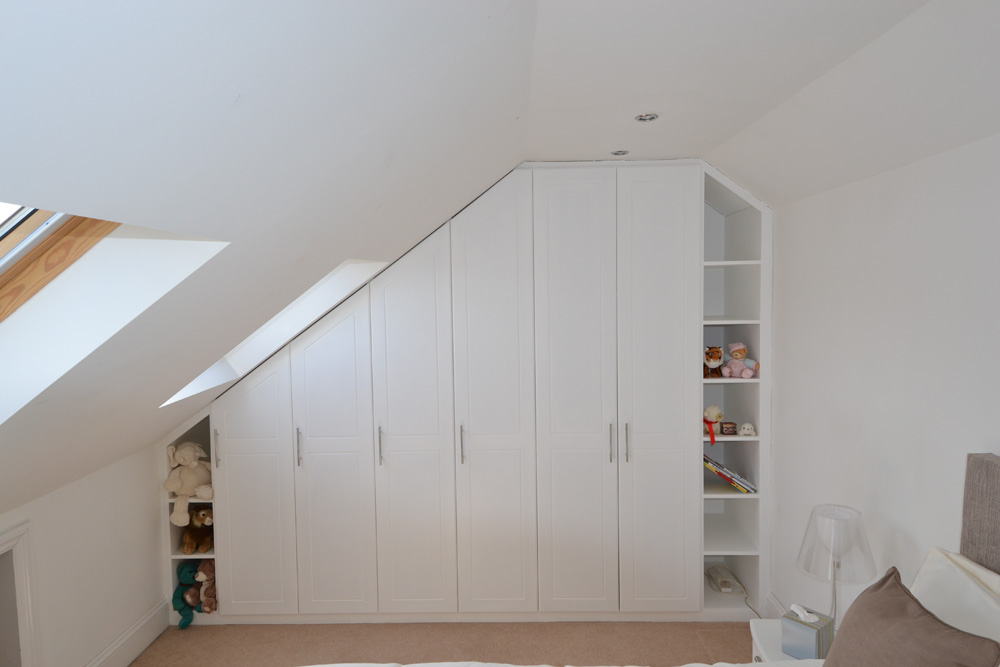Have you ever wondered if it’s possible to put a wardrobe in a loft?
At Lahart Carpentry, we understand the unique challenges that come with designing furniture for loft spaces.
We’ll delve into the considerations of size and layout, building regulations, and the types of wardrobes that are suitable for lofts. We’ll also share practical tips on how to maximise storage space and seamlessly incorporate a wardrobe into your loft.
So, if you’re looking to transform your loft into a functional and stylish living space, keep reading to discover the possibilities.
Size and Layout Considerations
When considering the placement of a wardrobe in a loft, it’s essential to carefully assess the size and layout of the space to ensure optimal functionality and aesthetic appeal. One of the first things to consider is any height restrictions that may be present in the loft. Lofts often have sloping ceilings or low beams, which can limit the height of the wardrobe. It’s crucial to measure the height of the space accurately to avoid any fitting issues.
Another important aspect is space usage. Lofts tend to have limited floor space, so it’s essential to maximise every inch. Custom designs can be a great solution for this, allowing you to tailor the wardrobe to the specific dimensions and layout of your loft. This way, you can make the most of the available space and ensure that the wardrobe fits seamlessly into the room.
Additionally, lighting options should be considered when placing a wardrobe in a loft. Since lofts often have limited natural light, it’s important to incorporate adequate lighting within the wardrobe itself. This can be achieved through built-in LED lights or strategically placed spotlights, ensuring that the contents of the wardrobe are well-illuminated.
Lastly, access points should be taken into account. Lofts can have narrow staircases or tight doorways, making it challenging to bring in large furniture pieces. It’s crucial to measure the access points and consider how the wardrobe will be delivered and installed in the loft.
Building Regulations and Restrictions
To ensure compliance with building regulations and avoid any potential restrictions, it’s important to consider the specific guidelines and requirements when installing a wardrobe in a loft. Legal requirements can vary depending on your location, so it’s crucial to check with your local building authority before proceeding with any modifications.
Height restrictions are often a concern when it comes to loft installations. Building regulations may specify a minimum ceiling height requirement to ensure proper functionality and safety. It’s essential to measure the height of your loft space accurately to determine whether it can accommodate a wardrobe.
Safety concerns are another important aspect to consider. Building regulations may outline safety measures such as fire safety, electrical requirements, and ventilation. These regulations exist to protect the occupants of the property and ensure a safe living environment.
Structural limitations can also impact the installation of a wardrobe in a loft. The loft structure should be able to support the weight of the wardrobe, including its contents. It’s advisable to consult with a structural engineer or a professional carpenter to assess the load-bearing capacity of your loft. Lahart Carpentry can take care of this for you.
Types of Wardrobes Suitable for Lofts
There are several types of wardrobes that are well-suited for loft spaces, providing both functionality and style. When it comes to design options, loft wardrobes offer a range of choices to suit different tastes and preferences. From sleek and modern designs to more traditional and rustic styles, there’s something for everyone.
One of the key benefits of loft wardrobes is their space-saving nature. They’re specifically designed to fit into the limited space that lofts often have. Whether it’s a built-in wardrobe that maximises vertical space or a sliding door wardrobe that saves on floor space, these options can help make the most of your loft area.
Customisation possibilities are another advantage of loft wardrobes. They can be tailored to fit your specific needs and requirements. With adjustable shelves, hanging rails, and drawers, you can create a wardrobe that perfectly suits your storage needs.
Maximising Storage Space in a Loft
One effective strategy for optimising storage space in a loft is by using smart organisational solutions tailored to the unique dimensions and layout of the space. When it comes to maximising storage in a loft, there are several key elements to consider.
Firstly, incorporating shelving solutions can make a significant difference. Installing shelves along the walls or in unused corners can provide additional storage for various items such as books, decorative objects, or even folded clothes. These shelves can be customised to fit the specific dimensions of the loft, ensuring that no space is wasted.
Hidden compartments are another clever way to maximise storage in a loft. Making us of hidden compartments within furniture pieces, such as beds or seating, can offer discreet storage options for items that aren’t frequently used. These hidden compartments can be designed to blend seamlessly with the overall aesthetic of the loft.
Custom fittings are essential in optimising storage in a loft. By having furniture pieces custom-made, they can be designed to fit perfectly into the available space, maximising storage potential. This includes custom-built wardrobes, cabinets, or drawers that are specifically designed to fit the dimensions and layout of the loft.
Vertical storage is a key consideration in a loft, as it allows for the full use of the vertical space available. Installing tall shelving units or installing wall-mounted storage solutions can help to make the most of the vertical space, providing ample storage for various items.
Practical Tips for Incorporating a Wardrobe in a Loft
When incorporating a wardrobe in a loft, it’s essential to consider the dimensions and layout of the space to ensure optimal storage solutions. Space saving solutions are key in making the most of the available area. Custom designs can be created to fit the unique shape and size of the loft, maximizing storage capacity. Utilising every nook and cranny, such as under eaves or stairs, can provide additional storage space.
Access and usability shouldn’t be overlooked when designing a wardrobe for a loft. Sliding doors or bi-fold doors can be a great space-saving option, as they don’t require extra clearance for swinging open. Additionally, incorporating pull-out drawers, shelves, and hanging rods at different heights can make it easier to reach and organise items efficiently.
Lastly, the decoration and styling of the wardrobe should complement the overall aesthetic of the loft. Using materials and finishes that match the existing design can create a cohesive look. Adding decorative elements like mirrors or decorative knobs can enhance the visual appeal of the wardrobe.



No responses yet